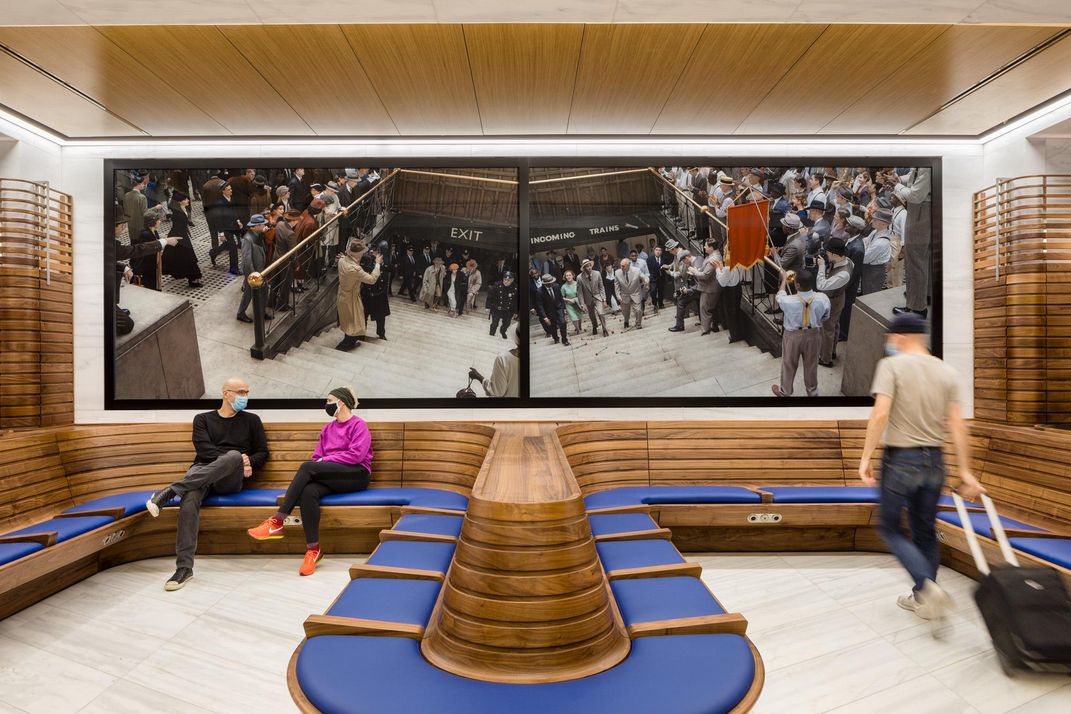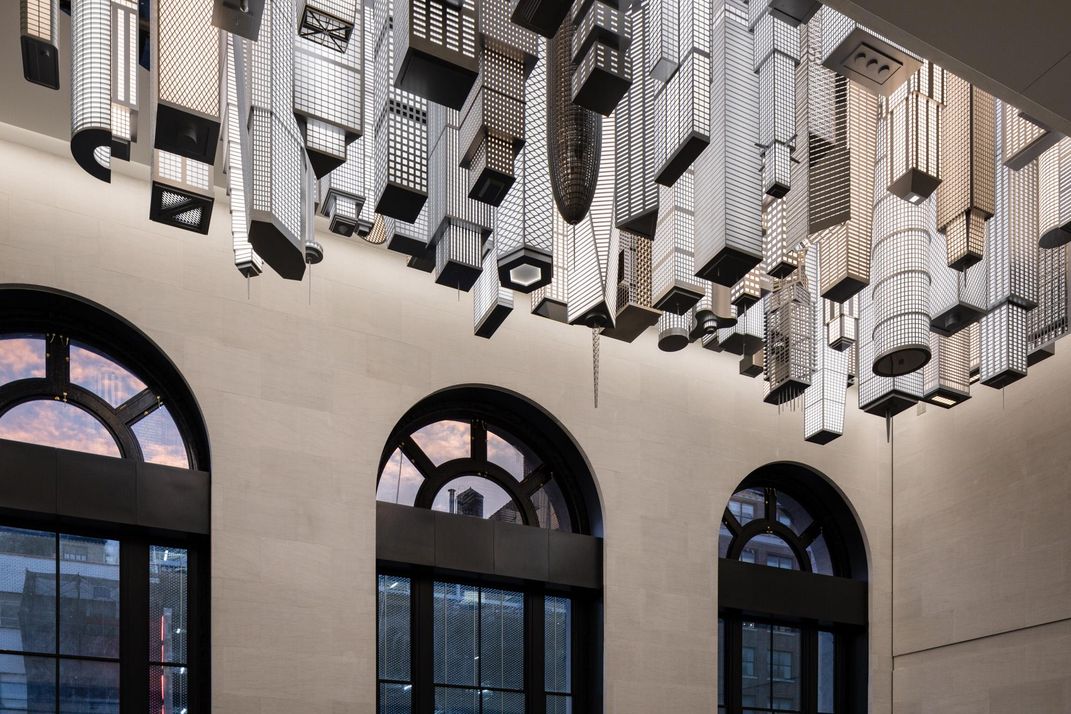See the Stunning Art Set to Welcome Travelers Back to Penn Station
Opening on January 1, the Moynihan Train Hall features contemporary art and majestic architectural features
Prior to the pandemic, the 650,000 commuters who passed through Penn Station every day were more likely to encounter dark, claustrophobic tunnels and rats scampering across subway tracks than world-class art. When travelers return to the New York City transit hub, however, they’ll find not only artistic masterpieces, but soaring skylights and a sleek, spacious waiting area reminiscent of the station’s demolished predecessor.
Dubbed the Moynihan Train Hall, the $1.6 billion, 255,000-square-foot space—located across the street from the main station in the historic James A. Farley Post Office—will serve as a central hub for Amtrak and Long Island Railroad passengers. Highlights of the venue, which is set to open January 1, include vaulted, 92-foot-high ceilings; art installations by Kehinde Wiley, Stan Douglas, and creative duo Michael Elmgreen and Ingar Dragset; a 6- by 12-foot suspended clock; and a one-acre sky-lit atrium.
“Is it grand? Yes. Is it bold? Yes, because that is the spirit of New York and that is the statement we want to make to our visitors, to our children and to future generations,” says Governor Andrew Cuomo, who unveiled the space Wednesday, in a statement. “As dark as 2020 has been, this new hall will bring the light, literally and figuratively, for everyone who visits this great city.”
Speaking with the New York Times’ Dionne Searcey, Wiley, who is perhaps best known for his presidential portrait of Barack Obama, describes the inspiration behind his contribution to the hall: Go, a hand-painted, stained-glass ceiling triptych that depicts young, black New Yorkers break dancing.
/https://tf-cmsv2-smithsonianmag-media.s3.amazonaws.com/filer/99/e0/99e098e7-1a75-4bdc-ad02-29492919e4e0/kehindewiley-7441.jpg)
“So much of what goes on in ceiling frescoes are people expressing a type of levity and religious devotion and ascendancy,” the artist tells the Times. “For me the movement and space made so much more sense thinking about ways bodies twirl in break dancing.”
Another artwork installed in the space, The Hive by Elmgreen and Dragset, mounts 91 upside-down buildings “on the ceiling like glowing, [nine]-foot-tall stalactites,” as Shaye Weaver writes for Time Out. Featuring 72,000 LED lights and six color-changing segments, the sculpture’s title reflects the collaborative nature of city life.
“It’s about a huge collaboration in order to make everyone survive,” Dragset explains to the Times.
The hall’s third public art installation, Douglas’ Penn Station’s Half Century, consists of nine oversized photographic panels documenting overlooked but significant moments in the transit hub’s history. To capture these scenes, the Canadian artist combined photos of contemporary actors posing in period costumes with digital renderings of the now-defunct station’s interior.
“With a cinematic quality, each scene revives history in uncanny detail, revealing this architectural landmark as a grand theater for the millions of human dramas that animate civic spaces and endow them with meaning,” says the Public Art Fund, which oversaw the three installations, on its website.
The Moynihan Train Hall’s opening marks the culmination of a decades-long push to convert the Farley building into an extension of Penn Station, reports Christina Goldbaum in a separate article for the Times. Proponents of the plan cited the need to expand the station, which serves three times as many riders as its architects anticipated, and a desire to atone for the original building’s much-criticized demolition in the 1960s. But critics argued that the proposal ignored the needs of subway riders, as the post office is located a sizable walking distance from the station’s subway lines.
A grand structure outfitted with quarried travertine and a 138-foot-high ceiling, the original Penn Station opened in 1910. Locals lauded it as an architectural marvel, but after the Great Depression, the building fell into a state of disrepair. Railroad executives eventually decided to sell the rights to the property and move a downsized version of the station underground.
The building’s untimely demise had unexpected consequences: As Michael Kimmelman wrote for the Times in 2019, “The historic preservation movement, which rose from the vandalized station’s ashes, was born of a new pessimism.”
Like the razed Penn Station, the nearby Farley building’s 1912 Beaux-Arts edifice was designed by architecture firm McKim Mead & White. Senator Daniel P. Moynihan first introduced plans to transform the space into an extension of the station in the early 1990s; as Jim Dwyer reported for the Times in 2016, the then-president of the New York City Transit Authority responded to Moynihan’s proposal by arguing that resources should be allocated to more pressing concerns, like repairing 80-year-old track switches.
In 2016, after decades of delays, Cuomo announced plans to renovate the station and expand into the Farley building. Though the newly completed revamp won’t solve many of the city’s transit problems—including track congestion and decrepit train tunnels—officials say it will help improve overcrowding and pave the way for future infrastructure projects.
“[The hall] speaks to the brighter days ahead when we will be able to congregate, to pass one another and to share the same space free of fear,” Cuomo tells the Times’ Searcey. “It promises renewal and rebirth of civic life in New York, and points to the opportunity ahead.”
/https://tf-cmsv2-smithsonianmag-media.s3.amazonaws.com/accounts/headshot/Isis_Davis-Marks_thumbnail.png)


/https://tf-cmsv2-smithsonianmag-media.s3.amazonaws.com/filer/8f/ce/8fce836a-75af-434c-9a79-18b6674ee2bf/kehindewiley-7567.jpg)
/https://tf-cmsv2-smithsonianmag-media.s3.amazonaws.com/filer/83/41/834126cd-d259-4cb1-ade6-fe24858d819f/50779771801_9d9e33cc46_c.jpg)
/https://tf-cmsv2-smithsonianmag-media.s3.amazonaws.com/filer/89/19/8919ba8a-bc72-40ea-9409-a6180fd64f9f/50779757506_272970b705_c.jpg)
/https://tf-cmsv2-smithsonianmag-media.s3.amazonaws.com/filer/51/d2/51d2c105-0388-4d74-aa5e-0e19a1ccefdf/50779875742_ec49bc0b2c_c.jpg)

/https://tf-cmsv2-smithsonianmag-media.s3.amazonaws.com/accounts/headshot/Isis_Davis-Marks_thumbnail.png)